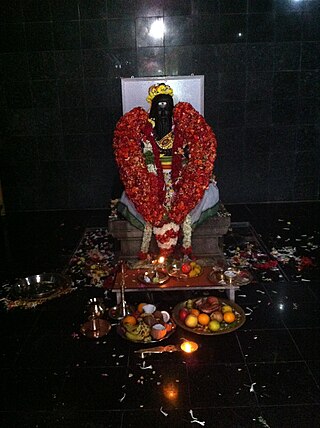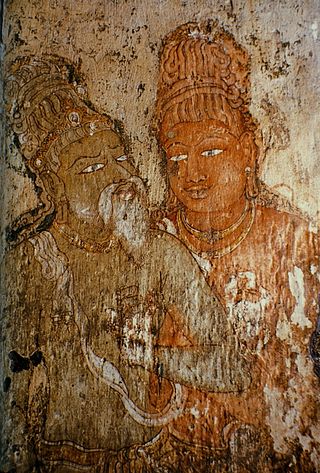Related Research Articles

Agastya was a revered Indian sage of Hinduism. In the Indian tradition, he is a noted recluse and an influential scholar in diverse languages of the Indian subcontinent. He and his wife Lopamudra are the celebrated authors of hymns 1.165 to 1.191 in the Sanskrit text Rigveda and other Vedic literature.

The Siddhar in Tamil tradition is a perfected individual who has attained spiritual powers called siddhi.

Siddha is a term that is used widely in Indian religions and culture. It means "one who is accomplished." It refers to perfected masters who have achieved a high degree of perfection of the intellect as well as liberation or enlightenment. In Jainism, the term is used to refer to the liberated souls. Siddha may also refer to one who has attained a siddhi, paranormal capabilities.

Dhanvantari is the physician of the devas in Hinduism. He is regarded as an avatar of Vishnu. He is mentioned in the Puranas as the god of Ayurveda.
Bogar, Bhogar, or Boganathar was a Tamil Shaivite Siddhar. He was a disciple of Kalangi Nathar. He was born in Vaigavur near Palani Hills. He received his education from his mother and his grand father described in several traditions and texts. Bogar himself describes his native roots in his book "Bogar 7000". Bogar went from Tamil Nadu to China and taught about enlightenment, this is also mentioned in his book Bogar 7000. Bogar is said to be in "nirvikalpa samadhi" below the sanctorum of Palani Murugan hill temple. The Tamraparniyan sea route was adopted by Bogar in his travels from South India to China via Sri Lanka.

The Subramaniya Swamy Temple, Marudhamalai, or the Marudhamalai Murugan Temple, is a popular 12th-century hill temple situated in Coimbatore, Tamil Nadu, India. Built by Tamil kings during the Sangam period as indicated in the Purananuru, the temple is dedicated to Lord Murugan and is considered the Seventh House of Lord Murugan.

Matsyendranātha, also known as Matsyendra, Macchindranāth, Mīnanātha and Minapa was a saint and yogi in a number of Buddhist and Hindu traditions. He is traditionally considered the revivalist of hatha yoga as well as the author of some of its earliest texts. He is also seen as the founder of the natha sampradaya, having received the teachings from Shiva. He is especially associated with Kaula Shaivism. He is also one of the eighty-four mahasiddhas and considered the guru of Gorakshanath, another important figure in early hatha yoga. He is revered by both Hindus and Buddhists and is sometimes regarded as an incarnation of Avalokiteśvara.

Gorakhnath was a Hindu yogi, saint who was the influential founder of the Nath Hindu monastic movement in India. He is considered one of the two notable disciples of Matsyendranath. His followers are known as Jogi(yogi), Gorakhnathi, Darshani or Kanphata.

Siddha medicine is a form of traditional medicine originating in southern India. It is one of the oldest systems of medicine in India.
Kalangi Nathar was an Indian ascetic who belonged to both the natha tradition of northern India and the siddha tradition of southern India. He was the guru of saint Bhogar and was born in Varanasi and belonged to the ancient tradition of nava (nine) nātha sadhus, tracing their tradition to Shiva.

Tamil mythology refers to the folklore and traditions that are a part of the wider Dravidian pantheon, originating from the Tamil people. This body of mythology is a fusion of elements from Dravidian culture and the parent Indus Valley culture, both of which have been syncretised with mainstream Hinduism.
C. Iyothee Thass was an Indian anti-caste activist and a practitioner of Siddha medicine. He famously converted to Buddhism and called upon the Paraiyars to do the same, arguing that this was their original religion. He also founded the Panchamar Mahajana Sabha in 1891 along with Rettamalai Srinivasan. Panchamas are the ones who are outcastes.

The Pothigai Hills, also known as Agasthiyar Mountain is a 1,866-metre (6,122 ft)-tall peak in the southern part of the Western Ghats of South India. The peak lies in Tirunelveli District of Tamil Nadu near the border of Kerala.
Kuzhanthai Velappar Temple is a Hindu temple in the Village of Poombarai near Kodaikanal in Dindigul.
Varma Kalai is a Tamil traditional art of vital points. It combines massage, alternative medicine, traditional yoga and martial arts in which the body's pressure points (varmam) are manipulated to heal or cause harm. The healing application called Vaidhiya Murai is part of Siddha medicine.

Sirumalai is a region of 60,000 acres (200 km2) situated 25 km (16 mi) from Dindigul, 90 km (56 mi) from Madurai, and 125 km from Trichy, Tamil Nadu, India. There are many high hills in the area. Sirumalai range is the last mountain range of the Eastern Ghats. The last mountains of the Sirumalai mountain range are the Azhagar Kovil Hills which are present in Madurai District. Azhagar Kovil Hills are the most important place of worship for the Hindu religion. Trekking is allowed in the Azhagar Kovil Hills. The nearest Eastern Ghats hills to Sirumalai Hills are the Narthamalai Hills.

Sri Kaagapujandar is considered to be an eminent siddha in Siddhar tradition, a saint who has reached a particularly high degree of physical and spiritual perfection. According to legends he lived around the 7th century CE. The jeeva samadhi of Sri Kaagapujandar is located at the Sornapureeshwar Temple in Thenponparapi village, near Chinna salem, Villupuram District. His birth star is Ayilyam. Sri Kaagapujandar was mentioned by Karuvoorar and author K.S.Pillai as one of the 18 siddhars.
Thycaud Ayyavu Swamikal was a spiritualist and a social reformer, the first to break customs related to caste in Kerala when caste restrictions and untouchability were at its extreme.
Muppu is seen as a major achievement in Siddha medicine. It is a combination of three salt-like substances. Muppu has a great purpose in medicine and alchemy. Siddhars used it as a catalyst of medicine. Traditional Siddha practitioners found that when the muppu was added to medicine it acted quickly and no patthiyam which is important in Siddha medicine. Scientific research work was done by Dr. C. Eleza BSMS MD PHD, of Tamil Nadu India whose book shows various facts.
“Pooneeru“ is one of the three salts according to Traditional siddha literature. The result of the chemical analysis of Khadi extracts showed that Khadi prepared from the Karunguruvai paddy grains (rice) was the best base solvent for ion exchange in the preparation of muppu than Samba Khadi. The analysis of the composition of these two types of Karunguruvai Khadi show that it is a good solvent for the elimination of heavy metals and for the enrichment of elements in Pooneeru powder (muppu), the chuurnam of Siddha drugs. These characteristics enhance the therapeutic potential and safety of the drugs for healing chronic diseases.

Karuvurar was a sage or Siddhar from Karuvur in Tamil Nadu, India. There are 18 Siddhars popularly known in Tamil literature. He is the one among the 18 Siddhars. Believers describe Siddhars as having the "ability to perceive the higher cosmic movements in universe." They are described as experts in Yoga, alchemy, literature, and philosophy, and as having the ability to move their souls to and from the bodies of others.
References
- ↑ R. N. Hema (December 2019). Biography of the 18 Siddhars (Thesis). National Institute of Siddha.
- ↑ "18 Siddhars". www.satsang-darshan.com. Archived from the original on 12 May 2023. Retrieved 12 May 2023.
- ↑ R. N. Hema (December 2019). Biography of the 18 Siddhars (Thesis). National Institute of Siddha.
- 1 2 White, David Gordon (2007) [1996]. The Alchemical Body: Siddha Traditions in Medieval India. University of Chicago Press. p. 111. ISBN 978-0-22614-934-9.